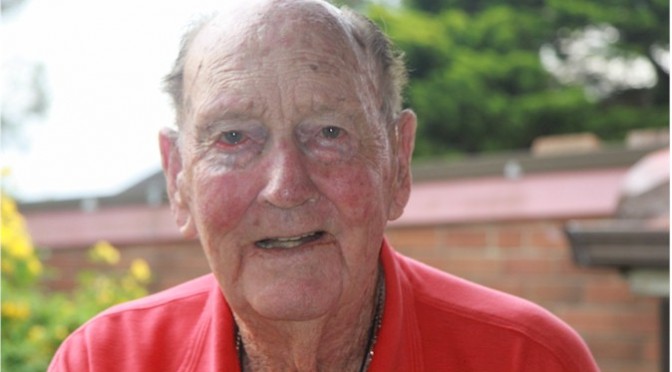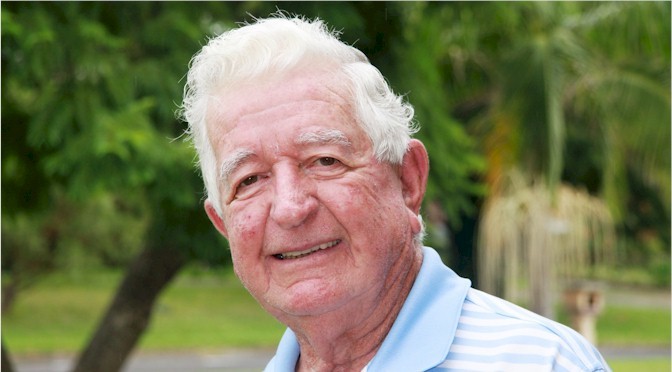| Project Name : Australian Golf Heritage Society Oral History Project | |
| For further information and a project brief, please contact: Curator/Collection Manager Australian Golf Heritage Society |
|
| Interview Length | 01:08:54 – edited 01:32:23 – archival |
| Interview Number | No.2 of series |
| Timed log | X |
| Name of interviewee | Dan Cullen |
| Date of Birth | 15/11/1914 |
| Date of Interview | 28/3/2013 |
| Place of Interview | Interviewee’s home/Little Bay, NSW Australia |
Technical Data – Sound Files
| Brand and Model of Digital Recorder | Zoom H4N |
| Brand and type of microphones used (with split cable adapter) |
Sony Condenser |
| Sound Storage Medium used – USB, CD – client | History Herstory has back-up copies |
| Location of Back-up | Home – various and Dropbox |
| Digital Recording Rate | Uncompressed WAV 24 bit 48 kHz archivalCD (WAV – 44.1/16) and MP3 – edited |
| Sound Field | Stereo |
Technical Data – Photographs/Images
| Full Title of each item | Dan Cullen portraits |
| Place/location where photograph was taken | Little Bay |
| Creator | Interviewer |
| Source Access/Restrictions/Copyright | Nil restrictions |
| Model of Digital Camera | Canon Digital SLR EOS 500D |
| File Format (eg JPEG, TIFF, RAW) | JPEG |
| Pixel dimension | 12 |
| No. of Images | 1 |
Documentation
| Signed Conditions of Interview Use Form | X |
| Signed release form for photos provided by interviewee | X |
| List of other relevant documentation | NA |
TIMED INTERVIEW SUMMARY
| Time | Subjects | Proper Names |
| 0:00 | Project introduction | AGHS –Australian Golf Heritage Society |
| 1:03 | Standard Genealogical information. Father was a schoolteacher – paid by exam results. Six sons in the family, 3 died in WW2. | Born Bunbury in Western Australia |
| 5:23 | Dan does not come from a golfing family. | |
| 5:38 | First involvement was in WA at Stuart Hill golf course built in bushland by Mr Hardy and Mr Douglas. Dan used to go with his brother to a fig tree on the course and steal figs. They were caught and as a punishment had to weed some of the golf course – this turned into caddying for Mr Hardy and Mr Douglas at weekends. Dan spent all his free time playing golf. Putting at Stuart Hill Golf Course was against an ordinary house brick until a Welshman named Eric Albert redesigned the course. | |
| 7:08 | Dan did not like school and left school the day he turned 14. The next day started work as an apprentice at the Pro Shop at the Yokine golf course – now the Western Australia Golf Club. There for 3 years. For the next 4 years he rode 17 miles each day, 7 days a week to Cottlesloe Course. He earned 1 pound per week. | Boss – Eric Albert |
| 9:27 | Joined Air Force for WW2 service at 28years at Woolloomooloo, Sydney NSW and found the arithmetic and algebra academically challenging but he persevered with his training and is extremely proud of getting through. | |
| 11:30 | Dan was 13 yo and his brother, James was 11yo when they stole figs. | |
| 12:16 | Won WA Open Championship in 1937 and 1938 at ages 22 and 23years. Became Nedlands Golf Pro, his first professional job. He followed his girlfriend Edith (still married to Edith) to Sydney in about 1940/1941. Bobby Locke had advised him to go to Sydney to develop his game/enhance his golfing career. | |
| 14:08 | During WW2 he played golf on leave at many courses including St Andrews in Scotland. Was an Officer and a Bomber Pilot. | |
| 14:57 | After WW2 applied for and got the Pro position at Roseville Golf Course and accepted the position despite not being allowed into the clubhouse. In the first week he played a game with Arthur Shoebridge (Road Commissioner), Gus Grayson and 2 other influential men who overturned the rule that Club Pros could not go into the clubhouse. At Roseville from 1946-1953. | |
| 16:53 | Very happy at Roseville. He secured the PGA to get played at Roseville – a coup / was assisted by Arthur Shoebridge. At this stage of his life Dan found that drink was a balm and a help for post war stress. No awareness of post war trauma or support offered to war veterans and he went downhill with drink while at Roseville. Leaving Roseville was mutually agreeable. | |
| 18:46 | Went to St Michaels as Golf Pro. Excellent golf Club and probably the best professional job for a Pro in Australia at the time. Was there for 23-24 years. Dan decided to build a golf range alongside the course. Sold the range in 2012 to St Michaels Club – was a good earner. | |
| 19:53 | Typical week at St Michaels. Monday – Catholic Clergy day, Tuesday – Ladies Day, Wednesday – ordinary day, ‘marker boys’ – a good crowd, Thursday – Competition Day, Friday – business men, lots of players. Sat and Sun – very busy. | |
| 22:43 | Taught on the 1st, 8th or 18th Fairway – risks of being hit so he started the driving range and taught there. Aboriginal boys used to wait in the bush and steal the golf balls so he carried a shotgun with him and fired it into the air to scare them away. Used to teach with the shotgun by his side. Made some handmade equipment and did repairs but manufactured clubs were much better. Used to buy ‘rough heads’ made of American persimmon – a head in a reasonable shape and used a rasp, file, another file then sandpaper to get a good head. Tools used were generic and not specific to golf. | |
| 28:05 | Playing career – loved the game, practised consistently. After winning the WA Championship twice he lived in Hurstville, NSW with Edith’s family but could not afford to play for 2 years and had no money to take up an offer to go to America. Very hard to be a Golf Pro and a playing professional. One of the paper boys suggested he play in the British Seniors; he played against Bobby Locke and came third. He went twice. He played in America twice for the Seniors and won money both times. Didn’t really take all the opportunities that were available to him. Went to the Far East Circuit with George Mansfield. | |
| 34:21 | Golf Pro in clubs role over the years. In Cottesloe in Perth he was treated very well as a boy but when he had to stay and sleep in the club he was given left over plate scraps reheated by the caterers for his meals. At Nedlands he was part of the ‘deal’. In Sydney, Mr Bourke at St Michaels and Lance McGowan were excellent – no letter writing, decisions were made verbally and promptly – no ‘bull dust’. Excellently run golf club. | |
| 39:04 | Changes in conditions for professional golfers – Boards had significant powers. | |
| 32:09 | Dan was chairman of the PGA and had a lot of contact with touring professionals – met them all – no disharmony between touring professionals and himself. Of latter years, Dan was aware there was discussion with some overseas players. Head of PGA for 3 years. | |
| 42:50 | Changes with clubs – hickory clubs – some broken every Saturday which usually had to be repaired overnight. Hickory could snap if it hit a bush. Drivers didn’t break as much. Less than 17/18 yo when steel shafts introduced. At the start repairers found it hard to fit the shafts, even the boss didn’t know what to do. | |
| 46:40 | Balls got better and better gradually. Top balls were Dunlop, Volley and balls from North British Rubber Company. 1934 costs were about 2 shillings; second grade was about 1/6d. | |
| 42:47 | Bags got bigger and bigger but in about 1986 players were allowed just 14 clubs. Dan talks about caddie duties when he was an assistant. | |
| 50:10 | Golf buggies – first one he ever saw was at Roseville after the war (WW2). Arthur Shoebridge – President of the club was the first he knew to own one. They became very popular. | |
| 51:00 | Asked Dan about role of caddies and Dan replied that he doesn’t really know. | |
| 51:50 | Golf clothing – as a young golfer Dan played in Plus Fours – ideal garment for golf in his opinion. | |
| 52:56 | Golf Course design has changed in that they are becoming more and more difficult with more hazards, more undulating greens – playing the ball out of a bunker is too hard. The game of golf is not as much fun as it was in the past. | |
| 55:14 | Consistent grass and better grass today. Couch fairways are best for our climate. Kikuyu not as good. | |
| 56:40 | Greenkeepers more knowledgeable now with better fairway mowers. | |
| 57:15 | Golf has been influenced by tournament players. | |
| 57:46 | Comments on PGA as a professional body and Golf Australia. | |
| 59:00 | Dan still teaches about 6 students at 98 years. For the last couple of years it has been getting more and more difficult as he can barely walk. Watches golf on TV. Philosophy on teaching – a golfer needs 3 qualifications: a pair of feet to stand on, a pair of hands to swing the club with and no brains. The golf swing has not changed much at all over the years in Dan’s opinion. Dan believes golf training has become too complicated. He taught everyday people. Bob Stanton was his most outstanding pupil (BS beat Arnold Palmer when he was about 18yo). Teaching gave Dan great satisfaction. | |
| 1:05:03 | Golf is spoken of as a funny game because it is unpredictable. Referred to Tiger Woods and his hard work and practice. | |
| 1:07:05 | Son and daughter both excellent competition standard players. | |
| 1:07:53 | Speaks of his 5 brothers – all outstanding sportsmen. |

